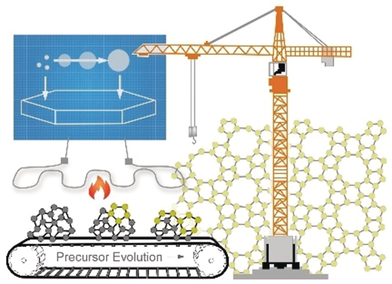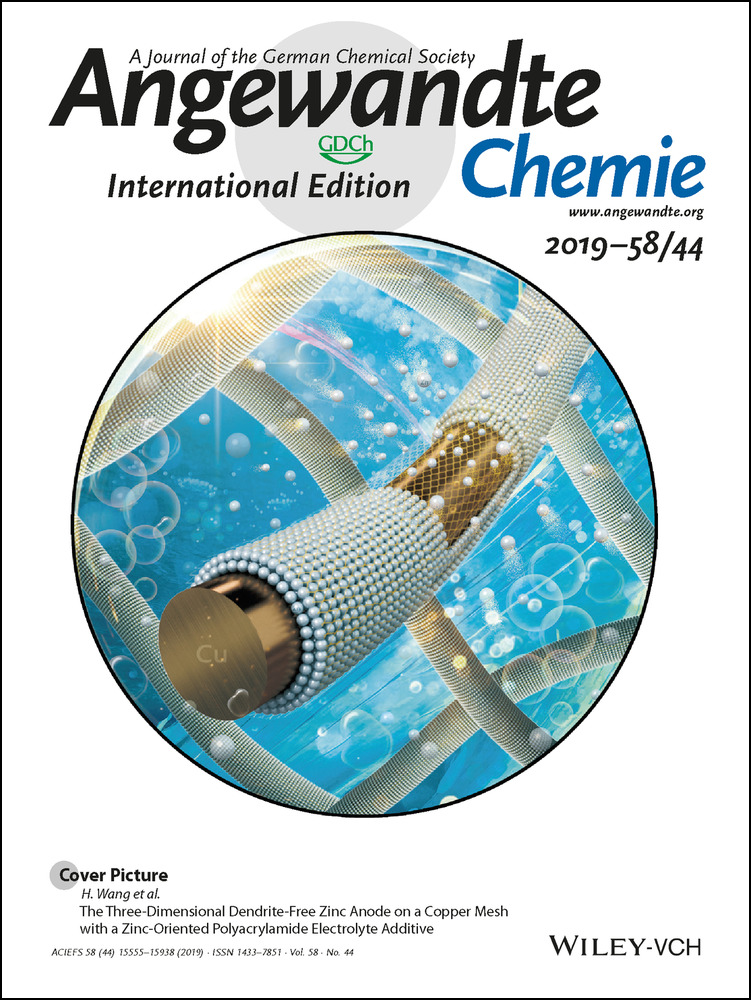Regulating Nonclassical Pathways of Silicalite-1 Crystallization through Controlled Evolution of Amorphous Precursors
Madhuresh K. Choudhary
Department of Chemical and Biomolecular Engineering, University of Houston, Houston, TX, 77204 USA
Search for more papers by this authorDr. Manjesh Kumar
Department of Chemical and Biomolecular Engineering, University of Houston, Houston, TX, 77204 USA
Search for more papers by this authorCorresponding Author
Prof. Jeffrey D. Rimer
Department of Chemical and Biomolecular Engineering, University of Houston, Houston, TX, 77204 USA
Search for more papers by this authorMadhuresh K. Choudhary
Department of Chemical and Biomolecular Engineering, University of Houston, Houston, TX, 77204 USA
Search for more papers by this authorDr. Manjesh Kumar
Department of Chemical and Biomolecular Engineering, University of Houston, Houston, TX, 77204 USA
Search for more papers by this authorCorresponding Author
Prof. Jeffrey D. Rimer
Department of Chemical and Biomolecular Engineering, University of Houston, Houston, TX, 77204 USA
Search for more papers by this authorGraphical Abstract
Abstract
Differentiating mechanisms of zeolite crystallization is challenging owing to the vast number of species in growth solutions. The presence of amorphous colloidal particles is ubiquitous in many zeolite syntheses, and has led to extensive efforts to understand the driving force(s) for their self-assembly and putative roles in processes of nucleation and growth. In this study, we use a combination of in situ scanning probe microscopy, particle dissolution measurements, and colloidal stability assays to elucidate the degree to which silica nanoparticles evolve in their structure during the early stages of silicalite-1 synthesis. We show how changes in precursor structure are mediated by the presence of organics, and demonstrate how these changes lead to significant differences in precursor–crystal interactions that alter preferred modes of crystal growth. Our findings provide guidelines for selectively controlling silicalite-1 growth by particle attachment or monomer addition, thus allowing for the manipulation of anisotropic rates of crystallization. In doing so, we also address a longstanding question regarding what factors are at our disposal to switch from a nonclassical to classical mechanism.
Supporting Information
As a service to our authors and readers, this journal provides supporting information supplied by the authors. Such materials are peer reviewed and may be re-organized for online delivery, but are not copy-edited or typeset. Technical support issues arising from supporting information (other than missing files) should be addressed to the authors.
| Filename | Description |
|---|---|
| anie201908751-sup-0001-misc_information.pdf1.7 MB | Supplementary |
| anie201908751-sup-0001-Movie_S1.avi5.1 MB | Supplementary |
Please note: The publisher is not responsible for the content or functionality of any supporting information supplied by the authors. Any queries (other than missing content) should be directed to the corresponding author for the article.
References
- 1S. Wang, Y. Peng, Chem. Eng. J. 2010, 156, 11–24.
- 2F. Su, C. Lu, Energy Environ. Sci. 2012, 5, 9021–9027.
- 3
- 3aU. Olsbye, S. Svelle, M. Bjørgen, P. Beato, T. V. W. Janssens, F. Joensen, S. Bordiga, K. P. Lillerud, Angew. Chem. Int. Ed. 2012, 51, 5810–5831; Angew. Chem. 2012, 124, 5910–5933;
- 3bA. Primo, H. Garcia, Chem. Soc. Rev. 2014, 43, 7548–7561;
- 3cB. M. Weckhuysen, J. Yu, Chem. Soc. Rev. 2015, 44, 7022–7024;
- 3dJ. Jae, G. A. Tompsett, A. J. Foster, K. D. Hammond, S. M. Auerbach, R. F. Lobo, G. W. Huber, J. Catal. 2011, 279, 257–268;
- 3eA. Chawla, R. Li, R. Jain, R. J. Clark, J. G. Sutjianto, J. C. Palmer, J. D. Rimer, Mol. Syst. Des. Eng. 2018, 3, 159–170.
- 4
- 4aC. Li, C. Paris, J. Martínez-Triguero, M. Boronat, M. Moliner, A. Corma, Nat. Catal. 2018, 1, 547–554;
- 4bE. M. Gallego, M. T. Portilla, C. Paris, A. León-Escamilla, M. Boronat, M. Moliner, A. Corma, Science 2017, 355, 1051–1054;
- 4cG. Bonilla, I. Díaz, M. Tsapatsis, H.-K. Jeong, Y. Lee, D. G. Vlachos, Chem. Mater. 2004, 16, 5697–5705;
- 4dT. M. Davis, A. T. Liu, C. M. Lew, D. Xie, A. I. Benin, S. Elomari, S. I. Zones, M. W. Deem, Chem. Mater. 2016, 28, 708–711;
- 4eS. K. Brand, J. E. Schmidt, M. W. Deem, F. Daeyaert, Y. H. Ma, O. Terasaki, M. Orazov, M. E. Davis, Proc. Natl. Acad. Sci. USA 2017, 114, 5101–5106;
- 4fA. Turrina, R. Garcia, A. E. Watts, H. F. Greer, J. Bradley, W. Z. Zhou, P. A. Cox, M. D. Shannon, A. Mayoral, J. L. Casci, P. A. Wright, Chem. Mater. 2017, 29, 2180–2190;
- 4gC. Jo, J. Jung, H. S. Shin, J. Kim, R. Ryoo, Angew. Chem. Int. Ed. 2013, 52, 10014–10017; Angew. Chem. 2013, 125, 10198–10201.
- 5
- 5aH. Awala, J.-P. Gilson, R. Retoux, P. Boullay, J.-M. Goupil, V. Valtchev, S. Mintova, Nat. Mater. 2015, 14, 447;
- 5bM. Kumar, M. K. Choudhary, J. D. Rimer, Nat. Commun. 2018, 9, 2129;
- 5cJ. J. De Yoreo, P. U. P. A. Gilbert, N. A. J. M. Sommerdijk, R. L. Penn, S. Whitelam, D. Joester, H. Zhang, J. D. Rimer, A. Navrotsky, J. F. Banfield, A. F. Wallace, F. M. Michel, F. C. Meldrum, H. Cölfen, P. M. Dove, Science 2015, 349, aaa 6760;
- 5dY. Liu, Y. Li, W. Yang, J. Am. Chem. Soc. 2010, 132, 1768–1769.
- 6
- 6aV. P. Valtchev, K. N. Bozhilov, J. Am. Chem. Soc. 2005, 127, 16171–16177;
- 6bS. Mintova, N. H. Olson, V. Valtchev, T. Bein, Science 1999, 283, 958–960.
- 7W. J. Roth, P. Nachtigall, R. E. Morris, J. Čejka, Chem. Rev. 2014, 114, 4807–4837.
- 8
- 8aN. Ren, S. Bosnar, J. Bronić, M. Dutour Sikirić, T. Mišić, V. Svetličić, J.-J. Mao, T. Antonić Jelić, M. Hadžija, B. Subotić, Langmuir 2014, 30, 8570–8579;
- 8bN. Ren, B. Subotić, J. Bronić, Y. Tang, M. Dutour Sikirić, T. Mišić, V. Svetličić, S. Bosnar, T. Antonić Jelić, Chem. Mater. 2012, 24, 1726–1737;
- 8cM. Kumar, H. Luo, Y. Román-Leshkov, J. D. Rimer, J. Am. Chem. Soc. 2015, 137, 13007–13017;
- 8dS. Kumar, T. M. Davis, H. Ramanan, R. L. Penn, M. Tsapatsis, J. Phys. Chem. B 2007, 111, 3398–3403.
- 9J. J. De Yoreo, P. G. Vekilov, Rev. Mineral. Geochem. 2003, 54, 57–93.
- 10A. Corma, Chem. Rev. 1995, 95, 559–614.
- 11
- 11aP.-P. E. A. de Moor, T. P. M. Beelen, B. U. Komanschek, O. Diat, R. A. van Santen, J. Phys. Chem. B 1997, 101, 11077–11086;
- 11bV. Nikolakis, E. Kokkoli, M. Tirrell, M. Tsapatsis, D. G. Vlachos, Chem. Mater. 2000, 12, 845–853;
- 11cB. J. Schoeman, Microporous Mesoporous Mater. 1998, 22, 9–22;
- 11dC.-H. Cheng, D. F. Shantz, J. Phys. Chem. B 2005, 109, 13912–13920;
- 11eS. Yang, A. Navrotsky, Chem. Mater. 2004, 16, 3682–3687;
- 11fC. J. Y. Houssin, C. E. A. Kirschhock, P. Magusin, B. L. Mojet, P. J. Grobet, P. A. Jacobs, J. A. Martens, R. A. van Santen, Phys. Chem. Chem. Phys. 2003, 5, 3518–3524.
- 12
- 12aA. I. Lupulescu, J. D. Rimer, Science 2014, 344, 729–732;
- 12bJ. N. Watson, L. E. Iton, J. W. White, Chem. Commun. 1996, 2767–2768.
- 13
- 13aJ. M. Fedeyko, J. D. Rimer, R. F. Lobo, D. G. Vlachos, J. Phys. Chem. B 2004, 108, 12271–12275;
- 13bS. Bosnar, T. Antonić Jelić, J. Bronić, M. Dutour Sikirić, S. Šegota, V. Čadež, V. Smrečki, A. Palčić, B. Subotić, J. Phys. Chem. C 2018, 122, 9441–9454.
- 14
- 14aT. M. Davis, T. O. Drews, H. Ramanan, C. He, J. Dong, H. Schnablegger, M. A. Katsoulakis, E. Kokkoli, A. V. McCormick, R. L. Penn, M. Tsapatsis, Nat. Mater. 2006, 5, 400–408;
- 14bJ. D. Rimer, D. G. Vlachos, R. F. Lobo, J. Phys. Chem. B 2005, 109, 12762–12771.
- 15M. Shete, M. Kumar, D. Kim, N. Rangnekar, D. Xu, B. Topuz, K. V. Agrawal, E. Karapetrova, B. Stottrup, S. Al-Thabaiti, S. Basahel, K. Narasimharao, J. D. Rimer, M. Tsapatsis, Angew. Chem. Int. Ed. 2017, 56, 535–539; Angew. Chem. 2017, 129, 550–554.
- 16A. I. Lupulescu, J. D. Rimer, Angew. Chem. Int. Ed. 2012, 51, 3345–3349; Angew. Chem. 2012, 124, 3401–3405.
- 17A. I. Lupulescu, W. Qin, J. D. Rimer, Langmuir 2016, 32, 11888–11898.
- 18W. Qin, A. Agarwal, M. K. Choudhary, J. C. Palmer, J. D. Rimer, Chem. Mater. 2019, 31, 3228–3238.
- 19
- 19aA. Tuel, Y. Ben Taǎrit, C. Naccache, Zeolites 1993, 13, 454–461;
- 19bX. Liu, Q. Luo, J. Phys. Chem. C 2017, 121, 13211–13217.
- 20J. D. Rimer, D. D. Kragten, M. Tsapatsis, R. Lobo, D. Vlachos, in Studies in Surf. Sci. and Catalysis, Vol. 154 (Eds.: ), Elsevier, Amsterdam, 2004, pp. 317–324.
- 21
- 21aA. Aerts, C. E. A. Kirschhock, J. A. Martens, Chem. Soc. Rev. 2010, 39, 4626–4642;
- 21bA. Patis, V. Dracopoulos, V. Nikolakis, J. Phys. Chem. C 2007, 111, 17478–17484.
- 22J. D. Rimer, O. Trofymluk, A. Navrotsky, R. F. Lobo, D. G. Vlachos, Chem. Mater. 2007, 19, 4189–4197.
- 23M. Choi, K. Na, J. Kim, Y. Sakamoto, O. Terasaki, R. Ryoo, Nature 2009, 461, 828.





